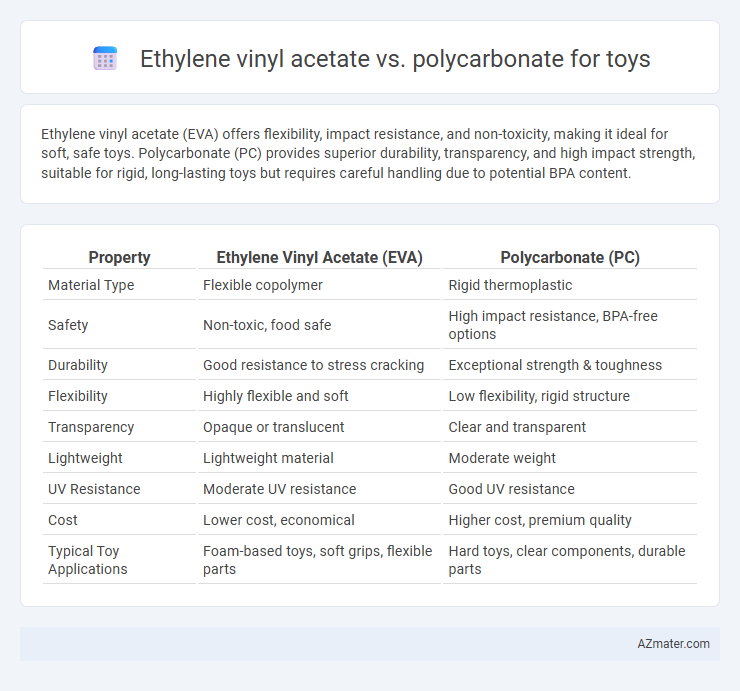Ethylene vinyl acetate (EVA) offers flexibility, impact resistance, and non-toxicity, making it ideal for soft, safe toys. Polycarbonate (PC) provides superior durability, transparency, and high impact strength, suitable for rigid, long-lasting toys but requires careful handling due to potential BPA content.
Table of Comparison
| Property | Ethylene Vinyl Acetate (EVA) | Polycarbonate (PC) |
|---|---|---|
| Material Type | Flexible copolymer | Rigid thermoplastic |
| Safety | Non-toxic, food safe | High impact resistance, BPA-free options |
| Durability | Good resistance to stress cracking | Exceptional strength & toughness |
| Flexibility | Highly flexible and soft | Low flexibility, rigid structure |
| Transparency | Opaque or translucent | Clear and transparent |
| Lightweight | Lightweight material | Moderate weight |
| UV Resistance | Moderate UV resistance | Good UV resistance |
| Cost | Lower cost, economical | Higher cost, premium quality |
| Typical Toy Applications | Foam-based toys, soft grips, flexible parts | Hard toys, clear components, durable parts |
Introduction: Comparing Ethylene Vinyl Acetate and Polycarbonate for Toys
Ethylene vinyl acetate (EVA) offers flexibility, shock absorption, and non-toxicity, making it ideal for soft, safe toy components. Polycarbonate (PC) provides superior impact resistance, transparency, and durability, suited for hard, structural toy parts. Choosing between EVA and polycarbonate depends on the balance of safety, durability, and design requirements for the intended toy application.
Material Properties: EVA vs Polycarbonate
Ethylene vinyl acetate (EVA) offers exceptional flexibility, softness, and impact resistance, making it ideal for safe, chewable toys and cushioning applications. Polycarbonate (PC) provides superior hardness, high tensile strength, and excellent clarity, suitable for durable, transparent parts requiring structural integrity. EVA's low density and chemical resistance contrast with polycarbonate's higher rigidity and better heat resistance, influencing their specific uses in toy manufacturing.
Safety and Toxicity Concerns in Toy Manufacturing
Ethylene vinyl acetate (EVA) offers excellent safety in toy manufacturing due to its non-toxic, hypoallergenic properties and resistance to cracking, reducing the risk of sharp edges. Polycarbonate (PC), while highly durable and impact-resistant, raises toxicity concerns because it can release bisphenol A (BPA), a chemical linked to hormonal disruptions, especially when exposed to heat or damage. Manufacturers prioritize EVA for toys intended for infants and toddlers to minimize toxic exposure, whereas PC is often reserved for products requiring greater strength and transparency but must undergo rigorous safety testing to ensure BPA levels are within acceptable limits.
Durability and Impact Resistance: Which Material Wins?
Ethylene vinyl acetate (EVA) offers excellent flexibility and cushioning, making it highly resistant to impact and ideal for safe, soft toys. Polycarbonate (PC) delivers superior durability with high tensile strength and exceptional impact resistance, ensuring long-lasting performance for rigid, structural toy components. For toys requiring rigid toughness and shatter resistance, polycarbonate outperforms EVA in durability and impact resistance, while EVA excels where softness and flexibility are prioritized.
Flexibility and Softness: EVA vs Polycarbonate in Toy Design
Ethylene vinyl acetate (EVA) offers superior flexibility and softness compared to polycarbonate, making it ideal for toys that require a cushioned, more pliable texture. Polycarbonate is rigid and impact-resistant but lacks the soft feel and pliability that EVA provides, which can enhance child safety by reducing hardness. In toy design, EVA is preferred for components needing flexibility and a gentle touch, whereas polycarbonate is suited for structural parts requiring toughness and durability.
Cost Analysis: Production and Retail Considerations
Ethylene vinyl acetate (EVA) offers lower production costs due to its simple molding process and raw material affordability compared to polycarbonate, which requires more complex manufacturing and higher-grade raw materials. Retail prices of EVA toys tend to be more budget-friendly, appealing to cost-sensitive markets, whereas polycarbonate toys, with their superior impact resistance and clarity, command higher retail prices justified by durability and premium quality. Cost analysis must weigh EVA's economic efficiency against polycarbonate's long-term value in safety and aesthetics for toy applications.
Aesthetic Qualities: Color, Transparency, and Finish
Ethylene vinyl acetate (EVA) offers vibrant color options with a soft matte finish, providing a flexible, slightly translucent appearance ideal for playful and safe toy designs. Polycarbonate (PC) stands out with superior transparency and a glossy, hard finish that enhances visual appeal and durability, allowing intricate details to remain visible. Choosing between EVA and polycarbonate depends on whether the toy prioritizes softness and color variety or clarity and a polished surface.
Environmental Impact and Recycling Options
Ethylene vinyl acetate (EVA) offers a lower environmental impact than polycarbonate due to its non-toxic composition and easier recyclability in standard plastic waste streams. Polycarbonate, while durable and transparent, poses recycling challenges because of bisphenol A (BPA) content and requires specialized facilities to break down safely. Choosing EVA for toys supports eco-friendly manufacturing with enhanced biodegradability and less chemical leaching, aligning with sustainable recycling practices.
Suitability for Different Toy Types and Functions
Ethylene vinyl acetate (EVA) offers exceptional flexibility and impact resistance, making it ideal for soft toys, puzzle mats, and protective padding in children's play areas. In contrast, polycarbonate (PC) exhibits superior rigidity, transparency, and durability, which suits it for hard, structural toys such as building blocks, protective helmets, and electronic toy casings. The choice between EVA and polycarbonate hinges on the toy's functional requirements, balancing softness and cushioning against strength and visual clarity.
Conclusion: Choosing the Right Material for Safe and Durable Toys
Ethylene vinyl acetate (EVA) offers flexibility, impact resistance, and non-toxicity, making it ideal for soft, safe toys designed for younger children. Polycarbonate provides superior strength, durability, and clarity, suitable for hard toys requiring longevity and resistance to breakage. Selecting between EVA and polycarbonate depends on the toy's intended use, safety standards, and required durability to ensure both child safety and product lifespan.

Infographic: Ethylene vinyl acetate vs Polycarbonate for Toy
 azmater.com
azmater.com